Label
Positions
The
term label position refers to the relationship
between the label and the record surface.
The first paper labels used by the Gramophone
Company were applied flush to the record
surface. A significant feature of this
position, one of considerable importance,
is that it generally allows one to see
the recording engineer’s information
engraved in the central area of the
recording tablet, impressed through
the label. Its major disadvantage is
that both the label itself and possibly
the recorded area may be damaged by
records rubbing against one another.
To correct this, Eldridge Johnson devised
a modified method affixing labels, for
which he applied for a patent on September
22, 1903, although it seems to have
been used at least a year earlier. This
method provided a plateau for the label
raised about 1/64 to 1/32 of an inch
above the record surface, which more
or less eliminated the rubbing of the
recorded area by records being stacked
one on another. The simplest way of
providing this plateau was to place
a round metal disc about 1/64 to 1/32
of an inch thick with a diameter just
slightly larger than that of the label
in use at the time in the center of
the finished wax recording. As this
would have obliterated any data inscribed
in the central area, the matrix number
was now entered in the runoff area of
the finished recording, usually close
to the edge of the recorded grooves.
This
change appears to have occurred between
April and August 1902, as this method
was in place by the latter date. A first
stamper pressing of Maurice Renaud’s
recording on G.C.-2-2713, matrix 2112
nB, issued in July/August 1902 shows
a raised label. Several stamper II pressings
from Pol Plançon’s issues in
May 1902 also show raised labels. Examination
of seven stamper II pressings from Caruso’s
first recording session reveals that
all have raised labels, and that all
of the engraved data seen on first stamper
pressings with flush labels has been
completely obliterated. Since all of
the first stamper pressings show engraving
outside the label itself, none of which
is apparent on stamper II pressings,
and in light of what we consider to
have been the manufacturing process
at that time, one cannot be certain
as to the mechanism used to achieve
these results. One can only say that
the area which was obliterated was considerably
larger than that of the label itself.
The period during which the raised label
was used did not extend much beyond
February 19, 1903, although three of
Caruso’s 1902 recordings with CO.
markings have raised labels.
The
record above, G.C.-52376, was recorded
by the Italian tenor Carlo Caffetto
in March 1902. It is a first stamper
pressing issued with a raised label.
The original inscribed matrix number
1686 can be seen faintly on the
left in the runout area, while a second
embossed matrix number, complete with
Fred Gaisberg’s G, was entered
at 6 o’clock. This disc shows a rather
early use of the raised label, since
it was followed by the Caruso recordings
of April 1902, of which all first stamper
pressings were issued with flush labels.
Moreover, it was assigned a catalog
number just before the last one assigned
to Caruso.
This
must be compared with a second Caffetto
recording, G.C.-52340, with a flush
label and the matrix number 1651
clearly visible under the label. This
was recorded after the Oxilia recording
described below, and before the later
Caffetto recording. All three of these
records are first stamper pressings,
and therefore appear to have been processed
and issued at times other than near
their recording dates.
Unfortunately,
this method did not reduce the wear
on the labels themselves. A further
modification introduced a slightly raised
ring surrounding the label, which was
still flush with the record surface
within the ring. This change occurred
some time after February 19, 1903, since
several instances of pressings from
the same stamper during this period
have been observed with both raised
labels and flush labels within a ring.
This change prevented wear and abrasion
of both the label and the recorded area.
In most instances the engineer’s markings
can still be seen impressed through
the label. However, a first stamper
pressing of G.C.-52332, with matrix
number 1630 and recorded earlier in
March 1902 than the Caffetto disc described
above, shows no matrix number. The label
appears to be flush within a slightly
raised ring that is not as deep as others
seen. Nevertheless, no markings of any
kind can be seen impressed through the
label, nor in the runout area other
than the catalog number. It would appear
therefore that at the time of the recording
the matrix number was inscribed in the
central area, and was somehow removed
before the issued record was pressed.
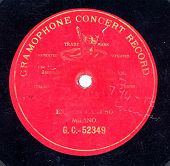 |
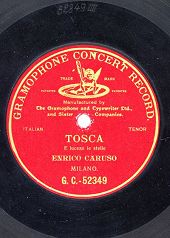 |
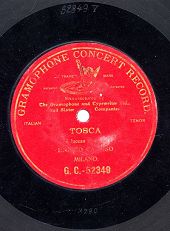 |
|
Stamper
I
|
stamper
IIII
|
Stamper
V, Riga
|
Pressings
from six different stamper of matrix
1790, Caruso’s first recording
of E lucevan le stelle made in
April 1902 show interesting variations
in the labels and in the visible information.
The figure on the left above shows the
matrix number 1790, Fred Gaisberg’s
G,
and the name Caruoso or Carouso
under the flush label, including the
so
outside
the label. Stamper II pressings show
no information other than the catalog
number at mid-12 o’clock and the matrix
number 1790 midway at 6 o’clock,
both embossed. The stamper IIII pressing
has a raised label, and while it shows
the catalog number, there is no matrix
number. Nevertheless the so
can
be seen outside the label.
The
stamper V pressing shown above has a
raised label made in Riga, but still
shows the so
outside
the label. The CO. marking at
3 o’clock would indicate that the stamper
was produced between February 19, 1903
and July 29, 1905
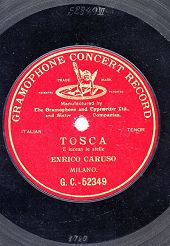 |
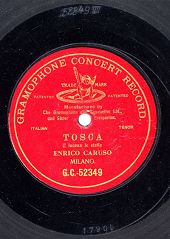 |
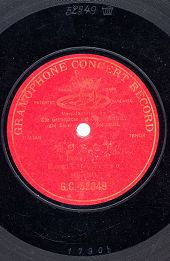 |
|
stamper
VI
|
Hanover
Stamper VII
|
Hanover
stamper VIII, Riga
|
All
of the original data in the central
area can be seen impressed through the
ringed flush label on stamper VI, as
well as a CO. marking and a newly
embossed matrix number in a different
position from that seen on earlier stampers.
The stamper VII pressing shows all of
the original information through a ringed
flush label, although the so
cannot be seen. In addition a new feature
seems to have been added, or at least
was begun to be added, as one can see
the beginning of Ca
under the original Caruoso.
The stamper VIII pressing from Riga
with a flush label within a raised ring
shows all of the engraving seen on the
stamper I pressing, while a stamper
VIII pressing from Hanover was issued
with a sunken label and shows no data
under the label. This implies that the
Riga plant received a metal part from
which still retained all of the information
engraved in the center of the recording
tablet. The Russian stamper V pressing
shows a CO. marking, indicating
that the metal part had been made, probably
at Hanover, after February 19, 1903.
(Author’s note: the Russian labels of
this period were notoriously poor.)
The
Oxilia record shown below, matrix number
1630, although recorded before
the Caffetto disc described above, matrix
number 1651, is a first stamper
pressing with a flush label within a
raised ring. It was probably manufactured
after July 29, 1905, at which time the
original stamper was still capable of
producing satisfactory pressings. No
information is visible through the label,
and there is no matrix number.
|
|
|
|
Recorded
in Milan in March 1902
|
The
rather unusual label below was recorded
in St. Petersburg in January 1904, and
is flush within a raised ring. The negative
image shows quite clearly the impression
of the handwritten matrix number
1772
L
incused
across the name Olimpia in the lower
half of the label, preceded by the recording
engineer Franz Hampe’s H.
The raised catalog number 53348 III
appears clearly across the top of the
trademark, while the CO. marking
appears just under the label at 9 o’clock.
A second matrix number can be seen completely
within the ring just under the label
at 6 o’clock. To the right of and above
the printed catalog number appear to
be markings by technicians at the Hanover
plant. It is quite characteristic of
Boronat’s first G&T recordings,
that she recorded essentially right
up to the edge of the label. Hence some
of Franz Hampe’s markings are often
seen at the very edge of the runoff
area, as shown below.
The
disc shown below was processed in Russia,
and bears the company designation in
Russian. It reveals the re-embossed
catalog number and stamper indicator
53348 GO 8, indicating the fifteenth
stamper, at the very top of the label,
which is now sunk below the record surface.
The original matrix number can be seen
just below the label at 6 o’clock.
A final change occurred after July
1905, when the label was sunk below
the record surface, which obscured any
inscriptions that had been made in the
central area. The reason for this last
change is not clear, since the previous
position had protected both the label
and the recorded area. A possible explanation
is that the company desired to hide
any information of that nature from
the public. Flush labels have been seen
on issues of 1910, and even of 1917,
these being Gramophone Company pressings
from imported Victor Talking Machine
Company metal parts., which still retained
such information as the artist(s) and
the matrix number in the central area.
In both instances the recordist’s data
may be seen impressed through the label.
|
|
|
 |
| |
|
|